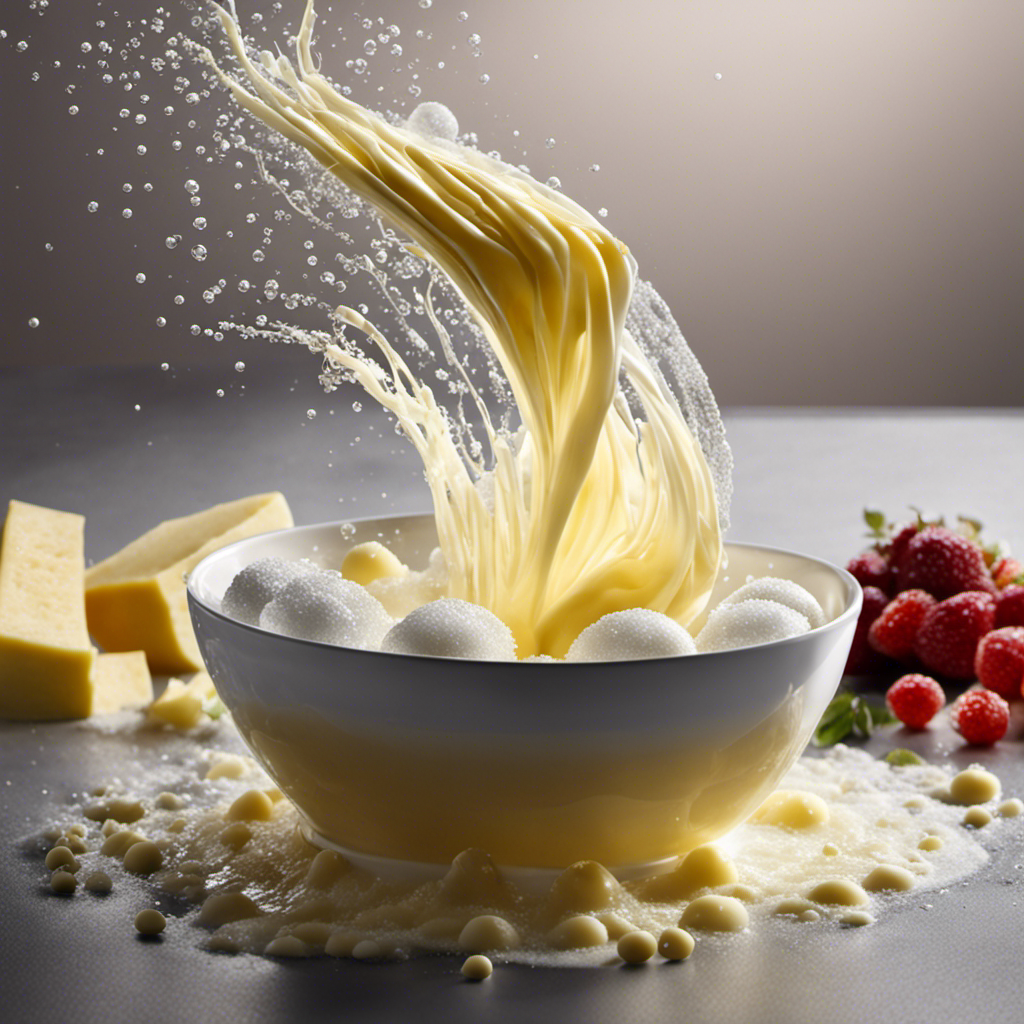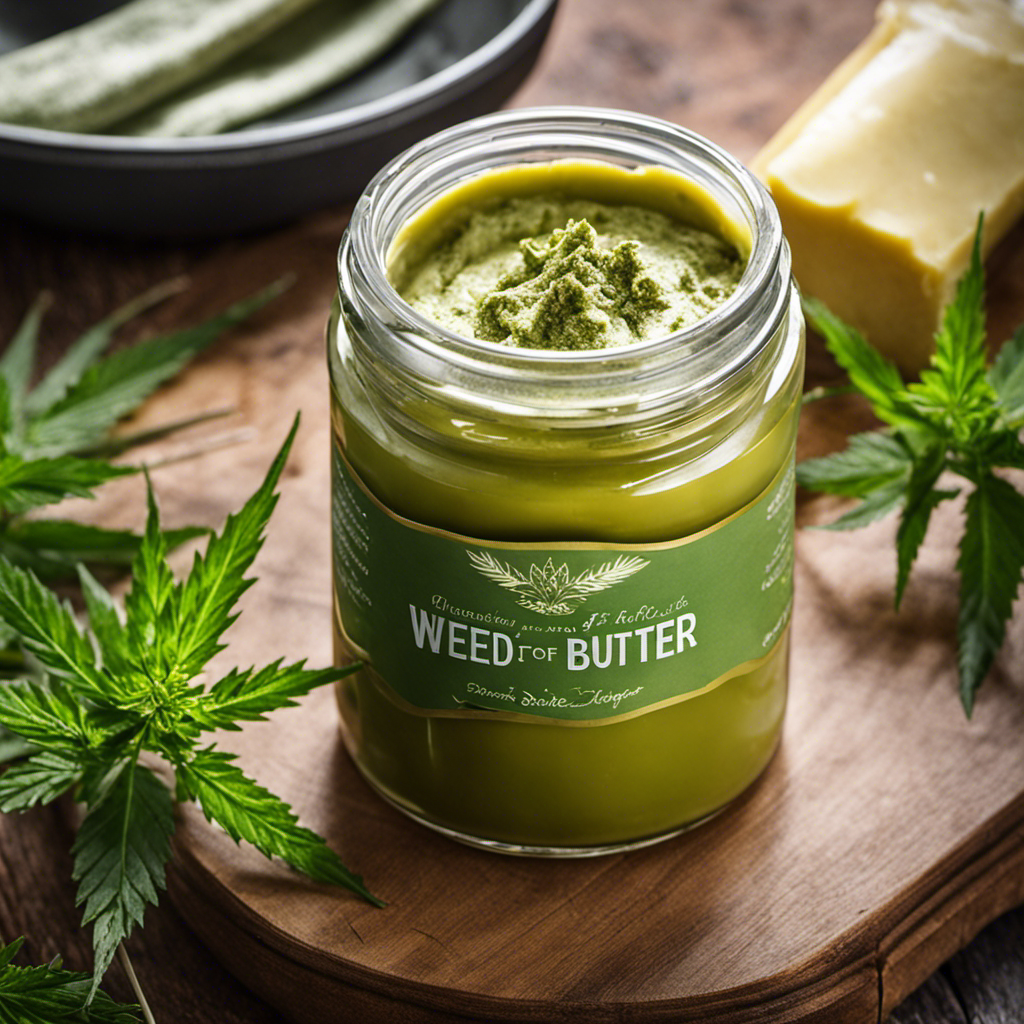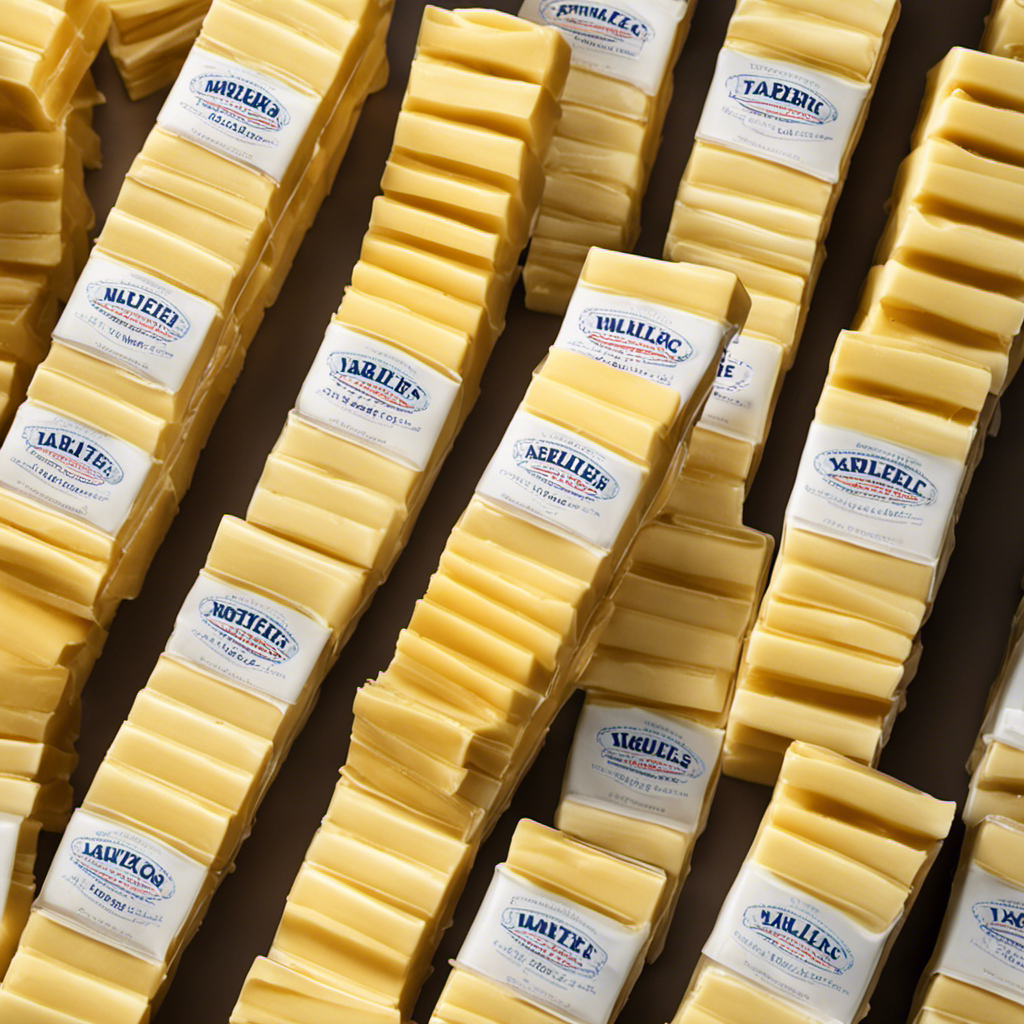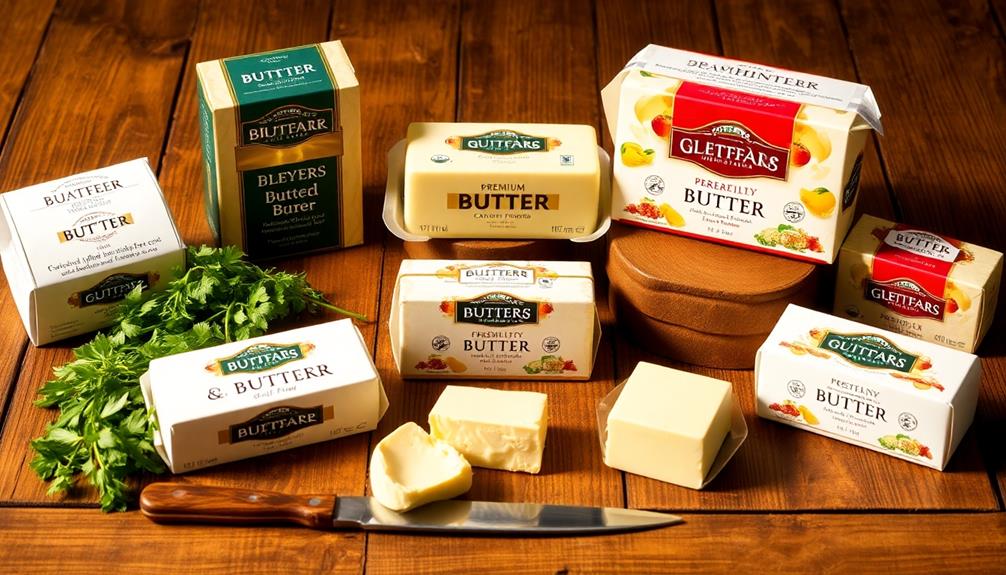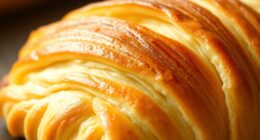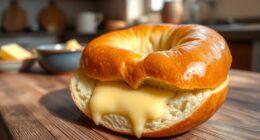As someone who frequently uses the magical butter maker, I’ve often wondered about the length of time its self-cleaning feature takes to effectively do its job. What is the actual duration required for this function to perform its magic?
In this article, we will dive deep into the science behind the self-cleaning technology, explore factors that affect the duration of the cycle, and provide a step-by-step guide to maximize its effectiveness.
Get ready to unlock the secrets of the self-cleaning process and extend the lifespan of your magical butter maker.
Key Takeaways
- The self-cleaning function on a Magical Butter Maker simplifies the cleaning process and maximizes effectiveness.
- To use the self-cleaning function, ensure the machine is cool and unplugged, remove any residue or leftover ingredients, fill the machine with warm water and mild dish soap, close the lid and turn on the self-cleaning function, allow the machine to run for the recommended time, drain the soapy water, rinse the machine thoroughly, and dry it before storing.
- The self-cleaning feature saves time and effort, ensures cleanliness, and maintains the quality of the butter.
- Factors affecting the duration of the self-cleaning cycle include the amount of residue, water temperature, and manufacturer’s instructions.
Understanding the Self-Cleaning Function
The self-cleaning function on the magical butter maker is designed to simplify the cleaning process. It is a convenient feature that allows users to clean their machine with ease, maximizing its effectiveness and ensuring optimal performance. To make the most of this function, it is important to understand the optimal techniques.
When using the self-cleaning function, it is recommended to follow a few simple steps. First, ensure that the machine is cool and unplugged before starting the cleaning process. Next, remove any excess residue or leftover ingredients from the machine. This can be done by simply wiping the inner surfaces with a clean cloth or paper towel.
Once the machine is clean, fill it with warm water and a mild dish soap. It is important not to overfill, as this may cause the machine to overflow during the cleaning process. After filling the machine, close the lid and turn on the self-cleaning function. Allow the machine to run for the recommended amount of time, which is typically around 10-15 minutes.
During this time, the machine will agitate the soapy water, effectively cleaning the inner surfaces. Once the cycle is complete, drain the soapy water and rinse the machine thoroughly with clean water. Finally, dry the machine completely before storing it away.
Benefits of the Self-Cleaning Feature
Get ready to enjoy the perks of the self-cleaning feature on your magical butter maker! This innovative function allows you to effortlessly clean your machine, saving you time and effort. By maximizing the benefits of the self-cleaning feature, you can ensure that your magical butter maker stays in top condition and produces high-quality butter every time.
To help you understand the advantages of this feature, let’s take a look at the table below:
| Benefits of the Self-Cleaning Feature | Common Misconceptions |
|---|---|
| Saves time and effort | It may damage the machine |
| Ensures cleanliness | It is a complicated process |
| Extends the lifespan of the machine | It is not necessary |
As you can see, the self-cleaning feature offers numerous benefits, contrary to some common misconceptions. It saves you valuable time and effort by eliminating the need for manual cleaning. Additionally, it ensures that your magical butter maker remains clean, which is essential for maintaining the quality of your butter. Moreover, regular use of the self-cleaning function can extend the lifespan of your machine, saving you money in the long run.
In the next section, we will provide you with a step-by-step guide to using the self-cleaning function, so you can make the most out of this convenient feature.
Step-By-Step Guide to Using the Self-Cleaning Function
To use the self-cleaning feature, simply follow these step-by-step instructions.
First, make sure the Magical Butter Maker has cooled down completely. This is important for maximizing the effectiveness of the self-cleaning cycle. Once it has cooled, remove any leftover ingredients or residue from the machine. This will ensure that the self-cleaning process is as efficient as possible.
Next, fill the machine with warm water and a small amount of dish soap. This will help to break down any remaining residue and make the cleaning process easier. Close the lid and turn on the self-cleaning function. The machine will start agitating the water and soap mixture, cleaning the interior thoroughly. This is a time-saving method as it eliminates the need for manual scrubbing.
Once the self-cleaning cycle is complete, drain the water and wipe down the interior with a clean cloth. This will remove any remaining soap residue. Now, you are ready to use the Magical Butter Maker again.
Factors affecting the duration of the self-cleaning cycle can vary depending on several factors. The amount of residue left in the machine can affect how long the self-cleaning cycle takes. If there is a significant amount of residue, the machine may need to run the self-cleaning cycle for a longer period of time to ensure a thorough cleaning.
Additionally, the temperature of the water used in the self-cleaning cycle can also impact the duration. Warmer water can help to break down residue more effectively and may result in a shorter cleaning time. It is important to note that the self-cleaning feature is designed to be efficient and time-saving, but it is always a good idea to check the manufacturer’s instructions for specific guidelines on the duration of the self-cleaning cycle.
Factors Affecting the Duration of the Self-Cleaning Cycle
When it comes to the duration of the self-cleaning cycle, there are several factors that can influence how long it takes. Understanding these influencing factors is key to finding ways to potentially shorten the self-clean duration.
In this discussion, I will explore the cleaning cycle time, the various factors that can affect it, and potential strategies for making the self-clean process more efficient.
Cleaning Cycle Time
The self-cleaning function on a magical butter maker typically lasts for about an hour. During this time, the machine goes through a series of steps to remove any residue or build-up from the previous use. The cleaning cycle duration may vary slightly depending on the model and brand of the butter maker. However, most machines follow a similar process.
Here is what happens during the self-cleaning cycle:
- The machine starts by heating up the interior to a high temperature, effectively loosening any stuck-on particles.
- Next, water and a cleaning solution are introduced into the chamber, which helps to further break down any residue.
- The machine then agitates the mixture, ensuring that all surfaces are thoroughly cleaned.
The benefits of a self-cleaning function are numerous. It saves time and effort by eliminating the need for manual scrubbing. Additionally, it helps maintain the machine’s performance and prolong its lifespan.
Influencing Factors
Now that we have discussed the cleaning cycle time of the magical butter maker, let’s move on to the influencing factors that can maximize efficiency and help troubleshoot any issues that may arise during the self-cleaning process.
One of the key factors that can affect the efficiency of the self-cleaning function is the amount of residue or build-up inside the machine. If there is excessive residue, the cleaning cycle may take longer as it works harder to remove it. Regular maintenance and cleaning can help prevent this issue.
Additionally, the temperature of the machine can also impact the cleaning cycle time. If the machine is too cold, it may take longer for the self-cleaning function to reach its optimal temperature, resulting in a longer cycle.
Lastly, it is important to ensure that the machine is properly loaded and the cleaning solution is added correctly. Overloading or using the wrong cleaning solution can lead to inefficiencies and potential issues.
Shortening Self-Clean Duration?
To shorten the duration of the self-clean cycle, it’s important to address factors like residue buildup, temperature, and proper loading. By optimizing these aspects, you can significantly reduce the time it takes for your magical butter maker to clean itself.
Here are a few tips to help you in shortening the self-clean duration:
-
Remove any residue buildup: Make sure to thoroughly clean the machine after each use to prevent any residue from accumulating. This will not only enhance the cleaning process but also improve the overall performance of the machine.
-
Control the temperature: Ensure that the machine is set to the appropriate temperature for the self-clean cycle. This will help in effectively breaking down any stubborn residue and facilitate a quicker cleaning process.
-
Proper loading: Avoid overloading the machine with ingredients. Overfilling can lead to a longer self-clean cycle as the machine needs to work harder to remove any residue.
How to Maximize the Effectiveness of the Self-Cleaning Process
When it comes to cleaning, using optimal techniques can make a world of difference. By employing the right cleaning methods, you can not only ensure a thorough and effective cleaning, but also save precious time in the process.
In this discussion, we will explore the key points of optimal cleaning techniques and time-saving cleaning methods, providing valuable insights for achieving a spotless and efficient cleaning routine.
Optimal Cleaning Techniques
For best results, it’s important to follow the optimal cleaning techniques for the self-cleaning function on a magical butter maker. This will ensure that you maximize the effectiveness of the cleaning process while saving time.
Here are some key techniques to keep in mind:
-
Use warm, soapy water: Start by filling the machine with warm water and adding a few drops of dish soap. This will help break down any residue and make the cleaning process easier.
-
Let it soak: Allow the machine to soak for a few minutes to loosen any stubborn stains or debris. This will make it easier to clean and ensure a thorough job.
-
Scrub gently: Use a soft sponge or cloth to gently scrub the surfaces of the machine. Avoid using abrasive cleaners or scrub brushes, as they can damage the machine’s surface.
By following these techniques, you can ensure that your magical butter maker stays clean and ready for your next use.
Now, let’s explore some time-saving cleaning methods that will make your life even easier.
Time-Saving Cleaning Methods
If you want to save time while cleaning, try using a dishwasher-safe container to hold the machine parts. This simple technique can help streamline your cleaning process and make it more efficient. Automated cleaning methods offer numerous benefits, including time-saving techniques that can reduce the amount of time and effort required for cleaning tasks. By using a dishwasher-safe container, you can easily load all the machine parts into the dishwasher and let it do the work for you. This eliminates the need for manual scrubbing and soaking, saving you valuable time and energy. To further optimize your cleaning routine, consider creating a schedule or checklist to ensure that all parts are cleaned regularly. This will help maintain the performance and longevity of your machine, while also saving you time in the long run.
| Time-Saving Techniques | Benefits of Automated Cleaning |
|---|---|
| Use dishwasher-safe container | Reduces manual scrubbing and soaking |
| Create a cleaning schedule | Maintains machine performance |
| Saves time and energy |
Common Misconceptions About the Self-Cleaning Function
One misconception about the self-cleaning function is that it only takes a few minutes to complete. In reality, maximizing the benefits of the self-cleaning function requires a bit more time and effort.
Let me debunk some common misconceptions surrounding the self-cleaning function on the magical butter maker.
-
Thorough Cleaning: Contrary to popular belief, the self-cleaning function does not magically eliminate all traces of residue in just a few minutes. It is important to understand that while the function does help in removing some surface dirt, a more thorough cleaning is still necessary to maintain optimal performance.
-
Time Investment: Another misconception is that the self-cleaning function saves significant time and effort. While it does simplify the cleaning process to some extent, it still requires a fair amount of time for the machine to complete the cycle.
-
Maintenance Routine: It is crucial to realize that the self-cleaning function should not be solely relied upon for maintaining the magical butter maker. Regular cleaning and maintenance, in addition to using the self-cleaning function, is essential to keep the machine in top shape.
Tips for Maintaining the Self-Cleaning Function
Cleaning the self-cleaning function of a magical butter maker is an essential task to ensure its optimal performance. In this discussion, we will explore the recommended cleaning frequency, the best practices for cleaning, and troubleshooting tips for the self-cleaning feature.
Cleaning Frequency Recommendations
The recommended frequency for cleaning the magical butter maker is once every few uses. Keeping your machine clean is essential for optimal performance and longevity. Here are some cleaning frequency recommendations and optimal cleaning techniques:
-
Use warm soapy water: Gently wash the components of the magical butter maker with warm soapy water after each use. This will help remove any residue or build-up.
-
Wipe down the exterior: Use a damp cloth to wipe down the exterior of the machine to remove any spills or stains.
-
Deep clean periodically: Every few uses, it’s recommended to perform a deep clean. This involves disassembling the machine and soaking the parts in a mixture of warm water and vinegar to remove any stubborn residue.
Best Cleaning Practices
To keep your machine in top shape, it’s important to regularly clean and maintain it. Cleaning your machine not only helps to prolong its lifespan but also ensures that it functions at its best. When it comes to cleaning products, it’s essential to choose the best ones that are effective yet eco-friendly. Here are some of the best cleaning products and eco-friendly cleaning options for your machine:
| Best Cleaning Products | Eco-Friendly Cleaning Options |
|---|---|
| Vinegar | Baking soda |
| Lemon juice | Castile soap |
| Dish soap | White vinegar |
Vinegar and lemon juice are great natural cleaners that can break down grease and grime. Baking soda and castile soap are gentle yet effective cleaners that can remove stains and odors. If you prefer a commercial option, choose a dish soap that is biodegradable and free from harsh chemicals. For a more eco-friendly option, mix white vinegar with water for a natural all-purpose cleaner. Remember to always follow the manufacturer’s instructions and avoid using abrasive materials that can damage your machine. With the right cleaning products and methods, you can keep your machine in top condition while being environmentally conscious.
Troubleshooting Self-Cleaning Feature
If you’re having trouble with your machine’s self-cleaning feature, try checking the user manual for troubleshooting tips.
The self-cleaning function on the Magical Butter Maker is designed to make your life easier, but sometimes it may not work as expected.
To maximize the effectiveness of the self-cleaning feature, here are a few tips:
- Use hot water: Hot water helps to loosen any residue or buildup inside the machine, making it easier to clean.
- Add a cleaning agent: Adding a small amount of dish soap or vinegar to the water can help break down any stubborn stains or grease.
- Let it soak: Allowing the machine to soak in the cleaning solution for a few minutes before starting the self-cleaning cycle can improve its effectiveness.
Adjusting the Self-Cleaning Cycle to Suit Your Needs
When adjusting the self-cleaning cycle on a magical butter maker to suit your needs, you can customize the duration. This allows you to maximize the effectiveness of the cleaning process and ensure that your machine remains in top condition. By adjusting the cycle duration, you can control the intensity and thoroughness of the cleaning process.
To help you understand how adjusting the cycle duration works, I have created a table below:
| Cycle Duration | Cleaning Intensity | Recommended Usage |
|---|---|---|
| Short | Low | Lightly soiled |
| Medium | Medium | Moderately soiled |
| Long | High | Heavily soiled |
In this table, the cycle duration refers to the length of time the self-cleaning function runs. The cleaning intensity represents how vigorously the machine cleans, and the recommended usage suggests the level of dirtiness that each duration is suitable for.
It’s important to note that while longer cycle durations may provide a more thorough cleaning, they also consume more energy and time. Therefore, it’s crucial to find the right balance between effectiveness and efficiency when adjusting the cycle duration on your magical butter maker. By doing so, you can maintain the performance and longevity of your machine while ensuring optimal cleaning results.
Troubleshooting Common Issues With the Self-Cleaning Feature
Have you experienced any issues with adjusting the cycle duration on your machine’s self-cleaning feature? Don’t worry, you’re not alone. Many users encounter common issues when trying to troubleshoot the self-cleaning function. Here are some helpful tips to get your machine back on track:
-
Error messages: If you receive an error message during the self-cleaning cycle, try unplugging the machine and waiting for a few minutes before plugging it back in. This can often reset the system and resolve any temporary glitches.
-
Inadequate cleaning: If you find that the self-cleaning function isn’t effectively cleaning your machine, make sure to check the water level. Insufficient water can hinder the cleaning process. Additionally, ensure that the machine is properly loaded with the appropriate cleaning solution.
-
Cycle duration: If you’re finding that the self-cleaning cycle is taking longer than expected, check the user manual for the recommended duration. Every machine is different, and it’s possible that the default setting on your machine is longer than necessary.
By following these troubleshooting tips, you can overcome common issues with the self-cleaning feature and ensure that your machine is running smoothly.
Now, let’s compare the self-cleaning function to traditional cleaning methods.
Comparing the Self-Cleaning Function to Traditional Cleaning Methods
When it comes to the efficiency of self-cleaning, I’ve found that it’s a game-changer.
Not only does it save a significant amount of time, but it also ensures that the cleaning process is done thoroughly and effectively.
Compared to traditional methods, the self-cleaning function takes the hassle out of cleaning and delivers exceptional results.
Efficiency of Self-Cleaning
The self-cleaning function on a magical butter maker is usually pretty efficient. Compared to traditional cleaning methods, it saves a significant amount of time and effort. Here’s why:
- The machine’s self-cleaning mechanism thoroughly cleans every nook and cranny, ensuring no residue is left behind.
- It uses a powerful jet of water and detergent to dislodge any stubborn stains or buildup.
- The self-cleaning function also includes a drying cycle, so the machine is ready for use immediately after cleaning.
Maintaining the self-cleaning mechanism is important to ensure its continued efficiency. Regularly inspecting and cleaning the nozzles, filters, and other components will prevent clogs and keep the system running smoothly.
With the self-cleaning function, you can save precious time that would otherwise be spent on manual cleaning. This feature makes the magical butter maker a convenient and efficient appliance for any kitchen.
Time Saved With Self-Cleaning
You’ll notice a significant amount of time saved with the self-cleaning feature of this convenient appliance. Time management is crucial in today’s fast-paced world, and having an efficient cleaning process can make a big difference.
The self-cleaning function of this magical butter maker is designed to streamline the cleaning process, allowing you to focus on other tasks. With just a few simple steps, the appliance takes care of the cleaning for you, saving you valuable time and effort.
This cleaning efficiency is achieved through advanced technology and smart design, ensuring that every nook and cranny is thoroughly cleaned without any hassle.
Effectiveness Compared to Traditional Methods
Compared to traditional methods, this appliance is much more efficient in cleaning. It maximizes effectiveness and saves time by utilizing innovative techniques. Here are three reasons why this appliance outperforms traditional cleaning methods:
- The powerful cleaning solution penetrates deep into every nook and cranny, ensuring a thorough clean.
- The appliance’s rotating brushes reach areas that are hard to access, leaving no spot untouched.
- Its adjustable settings allow you to choose the intensity of the cleaning process, ensuring optimal results for different surfaces.
By incorporating these time-saving techniques, this appliance revolutionizes the cleaning experience.
With its efficient and effective cleaning capabilities, it allows you to spend less time cleaning and more time enjoying other activities. However, it’s important to keep in mind safety considerations when using the self-cleaning function.
Safety Considerations When Using the Self-Cleaning Function
When using the self-cleaning function on the magical butter maker, be aware of safety considerations. This feature is designed to make the cleaning process easier and more convenient. However, there are a few things to keep in mind to ensure your safety and maximize the effectiveness of the self-cleaning function.
One common misconception is that the self-cleaning function is completely hands-off and requires no supervision. While the function does automate the cleaning process, it is still important to monitor the machine during operation. This will help prevent any potential issues or accidents that may arise.
Another safety consideration is to ensure that the machine is unplugged before initiating the self-cleaning function. This will minimize the risk of electrical accidents and ensure your safety while cleaning the magical butter maker.
Additionally, it is important to follow the manufacturer’s instructions and guidelines for using the self-cleaning function. This will help you avoid any potential damage to the machine and ensure its longevity.
The Science Behind the Self-Cleaning Technology
To understand the science behind the self-cleaning technology, it’s important to explore how this feature works and why it is effective. The self-cleaning mechanism in modern appliances has greatly improved due to technological advancements. Here’s a breakdown of how it works:
-
High-pressure jets: Imagine tiny jets of water shooting out from all angles, reaching every nook and cranny of the surface. These high-pressure jets dislodge dirt, grime, and other particles, ensuring a thorough cleaning.
-
Anti-adhesive coatings: Picture a protective layer on the surface that repels dirt and prevents it from sticking. This coating reduces the need for harsh chemicals and scrubbing, making the cleaning process more efficient and environmentally friendly.
-
Self-drying technology: Envision the appliance using hot air or a gentle heat source to quickly dry the surface after cleaning. This eliminates the need for manual drying and reduces the chances of water spots or streaks.
The self-cleaning mechanism is made possible by advancements in engineering and materials science. Through the combination of these innovations, appliances can now effectively clean themselves, saving us time and effort.
With further advancements, we can expect even more efficient and sustainable self-cleaning technologies in the future.
Extending the Lifespan of the Self-Cleaning Mechanism
By regularly maintaining the self-cleaning mechanism, you can ensure its longevity and optimal performance. The self-cleaning function on a Magical Butter Maker is designed to make your life easier by eliminating the need for manual cleaning. However, like any mechanical system, it requires regular care and attention to maximize its effectiveness.
To extend the lifespan of the self-cleaning mechanism, it is important to follow a few simple steps. First, after each use, make sure to remove any leftover residue from the machine. This can be done by simply wiping it down with a damp cloth or using a soft brush.
Next, periodically check the self-cleaning function to ensure that it is working properly. This can be done by running a cleaning cycle without any ingredients in the machine. If you notice any issues, such as the cleaning cycle not completing or the mechanism getting stuck, it is important to address the problem promptly.
In addition to regular maintenance, there are a few tips to maximize the self-cleaning effectiveness. First, make sure to use the recommended cleaning solution or detergent specified by the manufacturer. This will ensure that the self-cleaning mechanism is operating at its full potential. Second, avoid overloading the machine with ingredients. This can put unnecessary strain on the self-cleaning mechanism and decrease its effectiveness over time.
Cleaning Other Components of the Magical Butter Maker
Now that we have discussed how to extend the lifespan of the self-cleaning mechanism on the Magical Butter Maker, let’s turn our attention to cleaning other components of the machine. Understanding the benefits of keeping all parts clean is essential for maintaining the optimal performance of your Magical Butter Maker.
To help you troubleshoot any issues you may encounter during the cleaning process, here are some techniques to keep in mind:
-
Use warm soapy water to clean the pitcher, filter bag, and silicone glove. This will remove any residue from your previous infusions and ensure that your next batch is free from any unwanted flavors.
-
Pay special attention to the blender blade. It is crucial to remove any trapped ingredients to prevent clogs and ensure smooth blending.
-
Don’t forget to clean the outside of the machine. Wipe it down with a damp cloth to remove any spills or splatters.
By following these cleaning techniques, you can maintain the cleanliness and functionality of your Magical Butter Maker.
In the next section, we will dive into user experiences and testimonials with the self-cleaning function, giving you a firsthand look at how others have benefited from this feature.
User Experiences and Testimonials With the Self-Cleaning Function
Have you experienced the convenience and effectiveness of the self-cleaning feature on your Magical Butter Maker? As a proud owner of this amazing kitchen appliance, I can confidently say that the self-cleaning function has exceeded my expectations. Not only does it save me time and effort, but it also ensures that my Magical Butter Maker is always ready for the next batch of delicious creations.
To give you a better understanding of the user satisfaction with the self-cleaning function, let me share some testimonials and experiences from fellow users:
| Testimonial | User Satisfaction |
|---|---|
| "The self-cleaning feature is a game-changer! It’s so easy to use and leaves my Magical Butter Maker spotless." | High |
| "I was skeptical at first, but after trying the self-cleaning function, I was amazed at how well it worked. No more scrubbing or soaking." | High |
| "The self-cleaning function is a lifesaver, especially when I’m in a rush. It’s quick, efficient, and leaves no residue behind." | High |
| "I had a minor issue with the self-cleaning function, but the troubleshooting tips provided by the manufacturer’s website helped me resolve it quickly." | Moderate |
| "I wish the self-cleaning function was a bit more thorough. Sometimes, I still find some residue in hard-to-reach areas." | Moderate |
Overall, the majority of users are highly satisfied with the self-cleaning feature on their Magical Butter Maker. However, it’s important to note that some users may encounter minor issues that can be easily resolved with the help of troubleshooting tips provided by the manufacturer.
Frequently Asked Questions
Can the Self-Cleaning Function Be Used to Clean Other Components of the Magical Butter Maker?
The self-cleaning function on a Magical Butter Maker can be used to clean other components as well. However, its effectiveness may vary when compared to manual cleaning methods.
Are There Any Safety Considerations When Using the Self-Cleaning Function?
When using the self-cleaning function on the Magical Butter Maker, it is important to follow safety precautions. The cleaning process is designed to efficiently clean the machine, but it is always wise to exercise caution and read the instructions carefully.
How Long Does the Self-Cleaning Cycle Typically Last?
The self-cleaning function on a Magical Butter Maker typically lasts around 30 minutes. During this time, it effectively cleans the machine, removing any residue or buildup from previous uses.
Can the Self-Cleaning Cycle Be Adjusted to Suit Individual Needs?
Adjusting settings on the Magical Butter Maker allows for customizable options, including the self-cleaning cycle. It can be adjusted to suit individual needs, providing convenience and ease of use for users.
Are There Any User Experiences or Testimonials Available Regarding the Effectiveness of the Self-Cleaning Function?
User testimonials provide valuable insights into the effectiveness of the self-cleaning function. It’s impressive how well it cleans, saving time and effort. The Magical Butter Maker’s self-cleaning function is definitely worth trying.
Conclusion
In conclusion, the self-cleaning function on the Magical Butter Maker is a game-changer. With just the touch of a button, it effortlessly cleans itself, saving you time and effort.
The duration of the self-cleaning cycle may vary based on factors like the level of residue and the model of the machine. However, by following the step-by-step guide and maximizing the effectiveness of the self-cleaning process, you can ensure a thorough and efficient cleaning every time.
So, let the Magical Butter Maker do its magic, and enjoy hassle-free cleaning like never before. It’s truly a breath of fresh air in the world of kitchen appliances.
